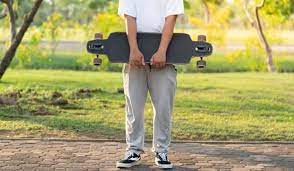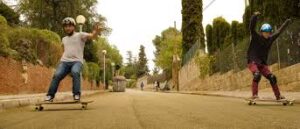In a world where the thrill of speed and the freedom of movement collide, longboard freeriding emerges as an exhilarating sport. With roots that trace back to the early days of skateboarding, this adrenaline-fueled activity has evolved into a unique blend of skill and style.

From carving through winding roads to executing gravity-defying slides, longboard freeriders push boundaries and defy limitations. In this article, we will delve into the history, techniques, gear, safety tips, and locations that make longboard freeriding a captivating pursuit.
Key Takeaways of What Is Longboard Freeriding
- Longboard freeriding originated in the 1970s as a form of skateboarding focused on downhill riding and tricks.
- Sliding for control, speed management techniques, and cornering with precision are essential techniques for longboard freeriding.
- Sliding involves intentionally breaking traction with the wheels, allowing the rider to drift or slide sideways, and is crucial for controlling speed and navigating sharp turns.
- Having the right gear, including a helmet, knee pads, and slide gloves, is essential for a safe and enjoyable longboard freeriding experience.
History of Longboard Freeriding
The history of longboard freeriding dates back to the 1970s when skateboarders began exploring new ways to ride their boards. Longboard freeriding emerged as a form of skateboarding that focused on downhill riding and performing tricks while maintaining control and speed. It quickly gained popularity among adrenaline junkies who craved the thrill of carving down steep hills and sliding around corners.

Over the years, longboard freeriding evolved, with riders pushing the limits of what was possible on a board. Today, there are countless best spots for longboard freeriding around the world. From iconic mountain roads like Malibu in California to scenic coastal routes like Cape Town’s Chapman’s Peak Drive, these locations offer breathtaking views and challenging terrain for riders seeking an exhilarating experience.
Essential Longboard Freeriding Techniques
In the world of longboard freeriding, mastering essential techniques is crucial for riders looking to take their skills to the next level.
Sliding for control allows riders to maintain stability and navigate sharp turns with confidence.

Speed management techniques are necessary to safely handle high speeds and maintain control while descending steep hills.
Additionally, cornering with precision requires a combination of skill and finesse, as riders must execute precise movements to navigate tight curves and corners effectively.
Sliding for Control
Sliding helps riders maintain control while freeriding on a longboard. Mastering the slide is essential for any longboarder looking to push their skills to the next level.
Sliding techniques involve intentionally breaking traction with the wheels, allowing the rider to drift or slide sideways. This technique not only adds style and flair to a rider’s repertoire but also serves as a crucial tool for controlling speed and navigating sharp turns.
The key to mastering the slide lies in weight distribution and balance. By shifting their weight towards the front or back of the board, riders can initiate and control slides with precision. Additionally, proper foot placement and carving techniques play a vital role in executing smooth slides while maintaining stability.
With practice and dedication, riders can become adept at sliding, enhancing their freeriding experience on a longboard.
Speed Management Techniques
When it comes to speed management on a longboard, riders can utilize various techniques.
One crucial aspect of controlling speed is mastering the art of braking. Longboarders have several braking techniques at their disposal, each with its own advantages and challenges.
The most common braking method involves dragging one foot on the ground behind the board while maintaining balance and control. This technique allows riders to gradually slow down or come to a complete stop if needed.
Another popular braking technique is known as footbraking, where the rider presses their sole against the road surface to create friction and reduce speed.
In addition to these braking techniques, body positioning plays a vital role in managing speed on a longboard. By leaning forward or backward, riders can shift their weight distribution and effectively control their momentum while riding downhill or at high speeds.
Cornering With Precision
To corner with precision, you’ll need to focus on your body positioning and lean into the turn. Improving cornering skills is crucial for longboard freeriders looking to take their riding to the next level. Advanced cornering techniques can help riders maintain control and maximize speed while navigating tight turns.
One important aspect of precise cornering is body positioning. As a rider approaches a turn, they should shift their weight towards the inside of the curve. This helps to maintain balance and control throughout the maneuver. Leaning into the turn also allows riders to transfer their weight onto the wheels that have better traction, increasing stability.
In addition to proper body positioning, understanding how speed affects cornering is essential. When entering a turn at high speeds, it’s crucial to gradually decrease speed before entering the curve rather than braking abruptly mid-turn. This prevents loss of traction and maintains control.
Longboard Freeriding Gear and Equipment
When it comes to longboard freeriding, having the right gear is essential for a safe and enjoyable experience. From helmets and pads to specialized gloves and shoes, there are several pieces of equipment that every freerider should have.
Choosing the right gear can make all the difference in terms of comfort, protection, and performance on the board.
Essential Gear for Freeriding
Make sure you have the essential gear for freeriding, such as a helmet, knee pads, and slide gloves. Freeriding is an exhilarating discipline of longboarding that requires specific equipment to ensure safety and enhance performance.
Here are some must-have items for any freerider:
- Helmet: Protecting your head is crucial in any extreme sport, and freeriding is no exception. A properly fitted helmet will safeguard against potential head injuries during high-speed descents and slides.
- Knee Pads: As you carve down hills and execute slides, your knees bear much of the impact. Knee pads provide cushioning and support to minimize the risk of injury.
- Slide Gloves: To perform controlled slides while maintaining stability, slide gloves are indispensable. These gloves feature durable palm pucks that allow riders to place their hands on the ground during slides without risking abrasions or burns.
Investing in these essential pieces of freeriding gear ensures a safer and more enjoyable experience on your longboard adventures. So gear up, hit the road, and embrace the thrill of freeriding!
Choosing the Right Equipment
Remember, having the right equipment is crucial for an enjoyable and safe experience as you embrace the thrill of freeriding. When it comes to longboard freeriding, finding the right board is essential. You’ll want a board that provides stability and control while allowing you to maneuver easily. Look for a longboard with a symmetrical shape and medium flex, as these characteristics offer versatility for various riding styles.
Additionally, choosing protective gear is just as important. Invest in a good helmet to protect your head from potential injuries. Don’t forget knee pads, elbow pads, and wrist guards to safeguard your joints during falls or slides.
With the right board and protective gear in hand, you’re ready to hit the road! Now let’s dive into some safety tips for longboard freeriding.
Transition: Now that you have all the necessary equipment, it’s time to learn how to stay safe while enjoying this exhilarating sport.
Safety Tips for Longboard Freeriding
To ensure your safety while longboard freeriding, don’t forget to wear a helmet and protective gear. Longboard freeriding can be an exhilarating activity, but it is important to prioritize safety. Here are some tips to keep in mind:
- Always wear a properly fitting helmet to protect your head from potential injuries.
- Wear knee pads, elbow pads, and wrist guards to prevent scrapes, cuts, and broken bones.
- Make sure your longboard is in good condition, with properly adjusted trucks and wheels.
Longboard freeriding requires skillful techniques such as sliding and carving. It’s essential to practice these techniques in a controlled environment before attempting more challenging terrains. By mastering the basics and continually improving your skills, you’ll be able to navigate downhill slopes safely.
Now that you know how important safety is in longboard freeriding, let’s explore the best locations for this thrilling activity.
Best Locations for Longboard Freeriding
After learning about safety tips for longboard freeriding, it’s time to explore the best locations for this thrilling activity. Whether you’re a beginner or an experienced rider, finding the right spot can make all the difference in your freeriding experience. Here are some top locations that offer a variety of terrain and challenges:
| Location | Terrain |
|---|---|
| Malibu, California | Smooth roads with breathtaking views |
| Barcelona, Spain | Urban streets and famous skateparks |
| Vancouver, Canada | Mountainous landscapes and bike paths |
| Sydney, Australia | Coastal roads with stunning scenery |
| Cape Town, SA | Long downhill runs with epic vistas |
When it comes to choosing the best longboard brands for freeriding, there are several options available. Some popular brands known for their durability and performance include Loaded Boards, Sector 9, Landyachtz, Arbor Collective, and Rayne Longboards. These brands offer a range of shapes and flex options to suit different riding styles and preferences.
To enhance your freeriding skills, consider learning some tricks like slides (such as stand-up slides or Coleman slides), carving techniques (like pumping or slashing), and dancing moves (combining flips and spins). Practice these techniques in controlled environments before attempting them on challenging terrains.
With the right location and equipment from reputable brands, you’ll be ready to take your longboard freeriding to new heights!
Longboard Freeriding Styles and Disciplines
If you’re looking to explore different styles and disciplines in the world of longboarding, there are several options for you to try out.
Longboard freeriding is a popular style that allows riders to express their creativity and push the limits of what’s possible on a board. Here are three techniques that can be incorporated into your freeriding repertoire:
- Sliding: This involves intentionally breaking traction with the wheels, allowing the rider to drift sideways while maintaining control.
- Dancing: A more fluid and artistic approach, dancing combines elegant footwork and body movements with smooth carving and flowing lines.
- Air tricks: For those seeking an adrenaline rush, mastering air tricks such as ollies, grabs, spins, and flips adds an exciting element to freeriding.
By learning these longboard freeriding tricks and techniques, riders can enhance their overall skill set and create unique experiences on their boards.
Transitioning from individual exploration to competitive events is a natural progression in the world of longboard freeriding competitions and events.
Longboard Freeriding Competitions and Events
Longboard freeriding competitions and events bring together the vibrant community of longboard enthusiasts who love pushing the limits of their skills and creativity. These events provide a platform for riders to showcase their talent and compete against each other in various disciplines such as downhill racing, slide jams, and freestyle tricks.
In these competitions, riders are evaluated based on their technical ability, style, and execution of tricks. Some popular longboard freeriding tricks include slides like stand-up slides, pendulums, and drifts; gravity-defying maneuvers like 180s, 360s, and shuvits; as well as dancing moves where riders showcase their balance and coordination.
These events not only offer an opportunity for riders to test their abilities but also foster a sense of camaraderie within the longboard freeriding community. It’s a chance for like-minded individuals to come together, share tips and techniques, cheer each other on, and celebrate the thrilling world of longboarding.
| Discipline | Description |
|---|---|
| Downhill Racing | Riders compete to reach the finish line first by descending down a hill at high speeds. |
| Slide Jams | Participants showcase their sliding skills by executing controlled slides on various surfaces. |
| Freestyle Tricks | Riders perform a variety of creative tricks that often involve spinning or flipping the board while maintaining control. |
Benefits and Challenges of Longboard Freeriding
One of the benefits of longboard freeriding is the opportunity to improve balance and coordination while enjoying an exhilarating activity. This sport requires riders to navigate downhill slopes, performing tricks and slides along the way.
Here are some additional benefits and challenges of longboard freeriding:
- Physical Fitness: Longboard freeriding is a great form of exercise as it engages various muscle groups in the body, including leg muscles, core muscles, and even arm muscles for balance. It helps to improve cardiovascular endurance and strengthens the body overall.
- Mental Focus: Freeriding requires intense concentration and focus. Riders need to make split-second decisions on how to maneuver their boards while maintaining control at high speeds. This helps to enhance mental agility, decision-making skills, and reaction time.
- Thrill and Adventure: The adrenaline rush experienced during longboard freeriding is unmatched. The joy of conquering challenging terrains, executing flips or slides successfully adds a sense of accomplishment that boosts confidence levels.
Longboard freeriding also comes with its fair share of challenges such as the risk of injury due to falls or collisions with obstacles on the road. Additionally, mastering advanced techniques can take time and practice. However, with proper training, safety gear, and perseverance, these challenges can be overcome for a rewarding experience in this thrilling sport.
Frequently Asked Questions
What Are the Different Types of Longboard Freeriding Styles?
Longboard freeriding styles include slides, downhill racing, and dancing. Different tricks can be performed such as stand-up slides and pendulum slides. Some top longboard freeriding gear brands are Loaded Boards and Sector 9.
Are There Any Longboard Freeriding Competitions or Events?
There are several longboard freeriding competitions and events that take place around the world. Riders showcase their skills and techniques while also prioritizing safety. Training techniques and safety tips are crucial for a successful experience.
What Are the Benefits of Longboard Freeriding?
Longboard freeriding offers numerous benefits, including improved balance, coordination, and cardiovascular fitness. However, it is essential to take safety precautions such as wearing protective gear and practicing in controlled environments to minimize the risk of injury.
What Are Some Popular Longboard Freeriding Locations?
Popular freeriding spots for longboarding include hills such as Maryhill Loops Road in Washington, The Snake in California, and Burke Mountain in Vermont. Riders often prefer drop-through or top-mount longboards for freeriding due to their stability and maneuverability.
What Are the Challenges of Longboard Freeriding?
The challenges of longboard freeriding include mastering techniques like sliding and carving, as well as dealing with the potential dangers of high speeds and steep hills. It requires skill, precision, and a keen sense of balance.
Conclusion
In conclusion, longboard freeriding is a thrilling and adrenaline-pumping sport that has gained popularity over the years. With its roots in skateboarding, this extreme sport offers a unique experience for riders of all levels.
As per recent statistics, it is estimated that over 7 million people worldwide participate in longboard freeriding. This impressive number showcases the growing interest and passion for this exhilarating activity.
Whether you’re a beginner or an experienced rider, longboard freeriding provides endless opportunities for fun and excitement on wheels. So grab your board, gear up, and embark on your own freeriding adventure!




